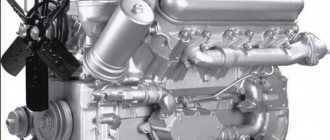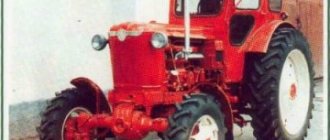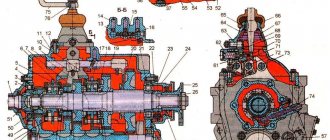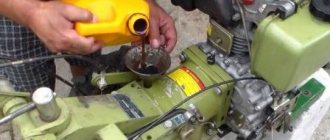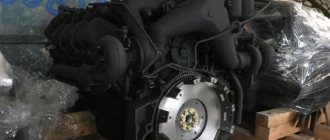ZMZ-53 is a gasoline V8, serially installed on the GAZ-53 family of cars produced in the period 1961-1993. This cargo line belongs to the third generation of medium-duty trucks of the GAZ family, which includes the GAZ-53F, GAZ-53A and GAZ-53-12 models. The GAZ-53 model was considered the most popular truck in the USSR. Its production volume exceeded 4 million copies.
Based on GAZ-53 in the period 1964-1992. They also produced a hybrid version of the GAZ-52 with a six-cylinder engine from the GAZ-51, as well as a greater load capacity than the regular 53rd model. According to the body layout in the style of a “sneaky look”, the GAZ-53 evokes similarities with the ZIL-130.
Design
As for the appearance, there is absolutely no archaism here, everything is simple down to the smallest detail. First of all, this model was in demand, also because of the spacious cabin for this class.
By the start of production, it was decided to move away from wooden cabins and use all-metal “capsules”, which also had pretty good passive safety. Although then, no one thought too much about people’s lives, but still, time passed, and a revolution awaited cars, precisely in our country.
In the front part, as expected, there is nothing complicated. The simplest hood design, allowing you to quickly begin repairs. And the bumper, which was really huge, allowed the repairman to stand confidently.
As for the “front”, after the 85th, a restyling was carried out, so to speak, a small update of the model. For the most part, which concerned the optics, and to some extent the cladding.
Otherwise, all the elements turned out to be the same, and differed only depending on the purpose of each machine.
Colors
The range of colors was represented by only seven colors: brown, green, blue, white, beige, yellow, black. The most common shades are blue and green.
Require topping up
Let us recall a joke from the 90s. A huge SUV has been sitting at the gas station for an hour. Fuel is poured into it, but the tank is not filled. The gas station attendant turns to the driver: “Perhaps you could turn off the engine?” In general, the gluttony of transport at today's gasoline prices has become a headache even for wealthy car owners.
On average, the price of AI-92 has increased by more than 6 percent since the beginning of May, and now this fuel costs almost 42 rubles per liter. And in some places the price reaches 45 rubles per liter of not the most environmentally friendly fuel. That is why interest in gas has almost doubled.
Let us recall that back in May 2013, the Russian government issued a decree “On regulating relations in the field of using gas motor fuel, including natural gas as a motor fuel.” According to it, at least half of Russian public transport will be switched to gas fuel. The planned amount of funding for the program until 2022 will be 110 billion rubles from the federal budget. However, before the May rise in gasoline prices, the issue of switching to natural gas motor fuel was not so relevant for private Russian car owners.
Along with rising prices for traditional fuel, a new problem has arisen. There are scams at many gas stations. That is, pour into the tank as much as will not fit there by definition. If the volume of fuel poured actually exceeds the technical capabilities of the car, this is not difficult to prove. Not a single gas station will enter into conflict. But if the driver simply knows that he can’t fit in so much, then this is not proof.
With gas, such fraud is practically impossible.
Homemade options for using the internal combustion engine ZMZ 53
Due to the unpretentiousness of engines of the ZMZ 53 series, their availability and relatively low cost, many “homemade” ones often try to “introduce” internal combustion engines into other brands of cars. For example, similar units have already been installed on Gazelle.
Despite the rather impressive dimensions, the “Gazonov” engines have a relatively light weight (230-270 kg), and the engine still fits under the Gazelle’s hood without loading the car very much. These engines are also installed in UAZ vehicles with appropriate modifications (the radiator is changed, the internal combustion engine mounts are reworked, etc.)
An example of a homemade tractor using a ZMZ 53 engine
Checking the technical condition of the internal combustion engine ZMZ 53
Some indicators can be used to judge the technical condition of the engine. These indicators are:
- oil consumption per 100 (1000) km;
- oil pressure values at idle and medium crankshaft speeds;
- compression in internal combustion engine cylinders.
Oil consumption is checked by level with a dipstick on a cold, unstarted engine. If consumption exceeds 0.4 liters per 100 km, the engine needs to be repaired. But the internal combustion engine can also be repaired with less oil consumption, especially when there are no leaks on the engine.
Oil pressure is controlled by a dial indicator and a warning lamp on the instrument panel. Sometimes sensors are faulty. Accurate readings can be obtained using a control pressure gauge. The minimum pressure at idle speed of the internal combustion engine should not be less than 0.5 kg/cm², at medium speeds this figure should not fall below 1 kg/cm². If the values are lower, the engine is sent for repair.
Compression in internal combustion engine cylinders is measured with a compression meter. This operation must be carried out by two people. Compression is measured with the spark plugs turned out, the throttle valve fully open, on a good battery and the power supply to the high-voltage wires is turned off. Good compression on ZMZ 53 is considered to be 7.5 kg/cm².
Gearbox oil
All lubricants used in transmissions and engines consist of a main component, as well as various additives. When the engine is running, its temperature increases. At the same time, the oil begins to foam and, of course, loses its lubricating properties. In order to prevent the properties of oils from deteriorating, special additives are added to their chemical composition, which correct and improve the performance characteristics of the lubricant.
In our online store you can purchase gearboxes for GAZ vehicles of various brands. For any questions, please contact our sales consultants.
In addition to lubricating the rotating gears, oil also acts as a heat remover from rubbing parts. When the car drives, the oil in the gearbox heats up to 150 °C. At the same time, in the places where the gears engage, the temperature reaches 300 °C. At this temperature, the lubricant foams and begins to perform its functions worse.
In cars with automatic transmission, oil transmits engine torque to gears. Therefore, when the lubricant foams and completely loses its viscosity, the car is simply unable to move. Practice has shown that additional radiators that cool the oil are ineffective here. Adding special additives to the lubricant is the best solution to this problem.
New engine for GAZ 53A
In 1964, the Zavolzhsky Motor Plant, based on the ZMZ 41 engine, developed a new engine that was equipped with the GAZ 53. It should be noted that six-cylinder internal combustion engines were no longer installed on the second generation of “lawns” (GAZ 53A), and in the future only “fifty-thirds” were equipped with V-shaped 8-cylinder engines.
The new internal combustion engine received the ZMZ index 53A. Just like the ZMZ 13, the engine received an aluminum block and two cylinder heads (cylinder heads) made of the same metal. The ZMZ 53A had a number of clear advantages over the outdated six-cylinder internal combustion engine:
- The engine weighed less;
- It had more power and cylinder capacity;
- Fails less often;
- It was more convenient to repair and maintain.
Main malfunctions of ZMZ 53 engines
Like any other engine, the ZMZ 53 has its weaknesses. Little depends on the modification; all internal combustion engines have similar characteristics.
- insufficient oil pressure in the lubrication system;
- deformation of the intake manifold (“spider”);
- oil leak from the rear main bearing;
- increased oil consumption;
- Under heavy loads, scuffing of the crankpin journals of the crankshaft occurs.
Nevertheless, the engines of this series are quite durable. If you consider the kind of motor oil that is sometimes poured into them, one can only be surprised at the tolerance of the internal combustion engine. Not every foreign-made engine can withstand such abuse.
You often hear from drivers of lawn cars, “That’s it, the engine is running out.” So, it can “end” for almost years. Without pressure, with a smoking piston and high oil consumption, the “lawn” drives for a long time. Very often, and sometimes for a long time, something knocks on “Gazonov” engines, but what exactly is not clear even after disassembling the unit. Surprising but true.
Reviews
Georgy, Petrozavodsk. It doesn’t matter at all how old this workhorse is. Simplicity, reliability, cross-country ability and ease of maintenance - these are the main advantages of the GAZ-53, which are necessary in work. The disadvantages include gluttony, lack of comfort and a stiff suspension, but with adequate maintenance the GAZ-53 will still serve me. I work on it in the countryside, and that’s where this bucket belongs.
Nikolai. In the late 80s I had the opportunity to work in a cooperative on a GAZ-53. Mostly positive memories remained from it, despite the cramped and spartan two-seater cabin, with poor visibility and mediocre ergonomics. Shaky suspension, fuel consumption of 25 liters, low-quality metal - in general, you can list as many as you like. However, in rural areas, the GAZ-53 seemed to be rehabilitated due to its high cross-country ability. And now it can be recommended for a start-up business or just lovers of the domestic automobile industry. In caring hands it will last as long as necessary.
What cars was the power unit installed on?
Motors were installed on cars from the Gas company (Gorky Automobile Plant). These were trucks that were equipped with tanks for various liquids. The engine was installed on vacuum trucks, van trucks, and fire trucks. Some UAZ models are also equipped with ZMZ 53 engines.
Similar article Technical characteristics of the 3S GE BEAMS engine
The cars were made with absolutely no comfort for the driver and passenger. The seats were made hard and power steering was not installed. Cabins in old cars are not heated in winter.
Recently, many car enthusiasts have been trying to modernize not only the engine, but also the car. I must say that they achieve a good effect.
But, despite the advantages of the engines of that time, they also had disadvantages. I'll tell you about them in the next block.
Correct engine maintenance
The engine itself is good and does not cause any complaints; the main thing is to maintain its technical condition.
This is what the internal combustion engine looks like for a GAZ 53 car
When carrying out maintenance, the cylinder head must be tightened.
But these are the first three technical inspections, then the frequency can be increased and the cylinder head can be tightened after each TO-2.
Don't forget about the temperature.
How often should antifreeze be changed?
The general recommendation for replacing coolant is to change
it is necessary at least once every two years or every 40-50 thousand kilometers.
But sometimes antifreeze
wears out even earlier.
Interesting materials:
How to record video from Samsung s9 Plus screen? How to record video from Skype screen? How to record video from the webinar screen? How to record screen recording on computer? How to protect your Apple Watch screen? How to Screenshot not the entire screen? How to move icons down on a computer screen? Which screen backlight is better? What buttons do you need to press to flip the screen on your laptop? What glue should I use to glue the screen?
Modifications
The variety of modifications of the GAZ-53 engine does not differ; the basis is the ZMZ-53 with some improvement in operating life and service. Some types of engine modifications can be distinguished:
| Type | Piston stroke, mm | Piston diameter, mm | Power, l. With. | Engine capacity, l |
| ZMZ-6606 | 92 | 80 | 120 | 4,25 |
| ZMZ-511 | 92 | 80 | 125 | 4,25 |
| ZMZ-523 | 92 | 88 | 130 | 4,68 |
see also
Comments 27
I usually flush the system with this oil. During operation on cars, and the Gazelle stopped at the Avangard, I will also pour it into the GAZon - it washes well, lubricates well, no signs of turning into fuel oil were found.
Was it dirty, has it become cleaner, or does it leave nothing behind?
It washes when the dirt is not on the walls in the form of deposits, but in the pan in the oil.
So the oil poured in front of the vanguard, say, under the valve cover, left traces of its presence and Lukoil corrected it? The opinion that if the oil quickly turns black means it washes is not entirely correct, a shaky engine can itself quickly dirty the oil
No not like this. Wash the engine, for example during disassembly or partial disassembly. Then fill it with fresh oil and drive away. After some time, we open the valve cover, for example (before the first replacement or after a couple of replacements) and look at the walls, they should not be covered in deposits. If the oil has not darkened after changing and running 5-6 thousand, I think it’s not oil, but bullshit. Because the design of the internal combustion engine is such that wear of the mechanical parts is always present. The oil flows into the pan and should wash away these wear products. Whatever the filter, it cannot, with the wave of a magic wand, lift everything from the pan and filter it. At its core, the sump is a sump. Clean oil with high mileage is a reason to think about the quality of the oil.
Yes, the oil is rubbish, I also pour myself LUKOIL Avant-Garde, both in KAMAZ and in Zila
I won’t argue, I filled it up for a temporary period so as not to drive on last year’s car while I’m working on the car, driving according to my needs, the mileage is insignificant without winter, I’ll eliminate the snotty, I’ll fill it with decent oil
But don’t you want to get rid of the centrifuge? on new tractors and machines there is a screw-on filter, you change the oil, unscrew it and install a new one, you just need to buy an oil filter housing and install it instead of a centrifuge and that’s all, well, that’s just advice))
We’re sitting at the table, everyone has already given in, and then one guy wants to clink glasses with another guy sitting on the other side, they grab a shot glass from the middle of the table, clink it with the one further away and return it, a friend next to him has five-ruble eyes rolling out with the words “why was that possible?” It is necessary to study the question of the feasibility of finding out what cleans better; from a financial point of view, a centrifuge is of course more economical


